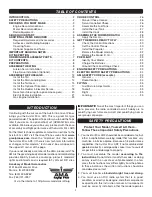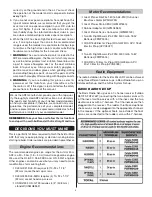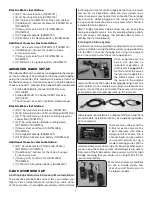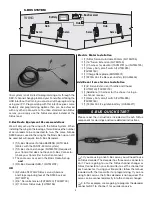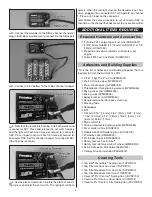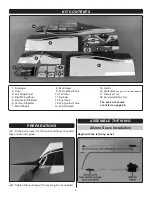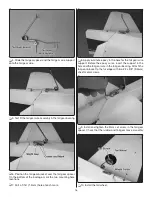
4
Electric Motor Installation
❍
(2) 24" Servo extensions (TACM2721)
❍
(3) 16" Servo extensions (FUTM4145)
❍
(2) Y-harness (TACM2751) For Flaps and Ailerons
❍
(1) Additional Y-harness for Elevator (TACM2751) or
(FUTM4135)
❍
(1) Heavy duty on/off switch (FUTM4385) or
(TACM2760)
❍
(1) Charge Receptacle (ERNM3001)
❍
(1) 3200 mAh LiFe Receiver battery (HCAM6446)
Additional Items for Gas Installation
❍
(2) 6" Servo extensions (FUTM4140) (TACM2700)
❍
(1) Additional Y-harness for choke if using a
6-channel receiver
❍
(1) Heavy duty on/off switch (FUTM4385 or
TACM2761)
❍
(1) 1300 mAh LiFe ignition battery (HCAM6411)
ADVANCED RADIO SET-UP
The Advanced Set-up has each servo plugged into the receiver
on its own channel. The channels can then be mixed together
using the transmitter. This method will require at least an
8-channel receiver. A 9-channel receiver if using the optional
choke servo and 11-channels if the optional fl oats are installed.
❍
Futaba R6008HS 8-channel FASST Receiver
(FUTL7639)
❍
Futaba R6014HS 14-channel FASST Receiver
(FUTL7645)
❍
The same servos used in the Basic Radio Set-up
Electric Motor Installation
❍
(2) 24” Servo Extension (Ailerons) (TACM2720)
❍
(3) 16” Servo Extension ( ESC and Flaps) (FUTM4145)
❍
(4) 12” Servo Extension (Aileron and Flaps receiver
connection) (TACM2710)
❍
(3) 6” Servo Extension (Rudder and Elevators)
(FUTM4140) (TACM2700)
❍
(1) Heavy Duty on/off switch (FUTM4385)
(TACM2760)
❍
(1) Charge Receptacle (ERNM3001)
❍
(1) 3200mAh LiFe Receiver battery (HCAM6446)
Additional Items for Gas Installation
❍
(2) 6” Servo Extension (Throttle and Choke) )
(FUTM4140) (TACM2700)
❍
(1) Additional Y-harness for the choke if using a
6-channel receiver
❍
(1) Heavy Duty on/off switch (FUTM4385)
(TACM2760)
❍
(1) 1300mAh LiFe ignition battery (HCAM6411)
S.BUS SYSTEM SET-UP
A Cutting Edge Alternative to Standard Servo Installation!
The innovative Futaba S.Bus system lets you unleash your
fl ight system’s full potential and cut down on cable clutter
at the same time. It uses digital serial data communication
technology to transmit control signals between your receiver
and servos. A single S.Bus cable can carry signals to as
many channels as your transmitter can handle. You no longer
have to worry about plugging in the wrong servo to the
wrong channel, because each servo knows what channel it
is dedicated to in advance.
SBD-1 S.Bus Decoder Cables allow the use of existing
analog and digital servos, too. By providing today’s pilots
with tomorrow’s technology, the Futaba S.Bus system is
nothing short of revolutionary.
Installing the S.Bus System
Installation is actually simplifi ed as compared to your normal
system installation. Using the S.Bus system you plug a battery
into the SBC-1 channel changing tool, using it to program
which channel you want the servo to operate on.
Once programmed the
servo will operate as
required regardless of
which lead it is plugged into.
Do this for all of the servos
that you want to operate on
the S.Bus system. Install
the servos in the airplane
and plug them into the S.Bus lead, piggybacking them one
onto another. Once completed you plug one lead into the
receiver for all of the servos and all of the servos will function
as programmed. One lead operates up to 16 servos!
S.Bus leads are available in a number of different lengths to
accommodate installation into any size airplane regardless
of its complexity.
There are many choices for the
S. Bus receivers; some are tiny
3 port receivers with others
being up to 8 channels. The 8
channel inputs can be used as
you would normally set up a
model, allowing you to split the
model and have some of it set up as S.Bus while other servos
are not using the S. Bus system. Something else to note is
that some of the S. Bus servos and receivers are HV or High
Voltage, meaning that you could run a straight 2S LiPo for
your receiver battery.
Many servo choices are available
for use in a wide variety and
sizes of aircraft from micros to
the largest models.


